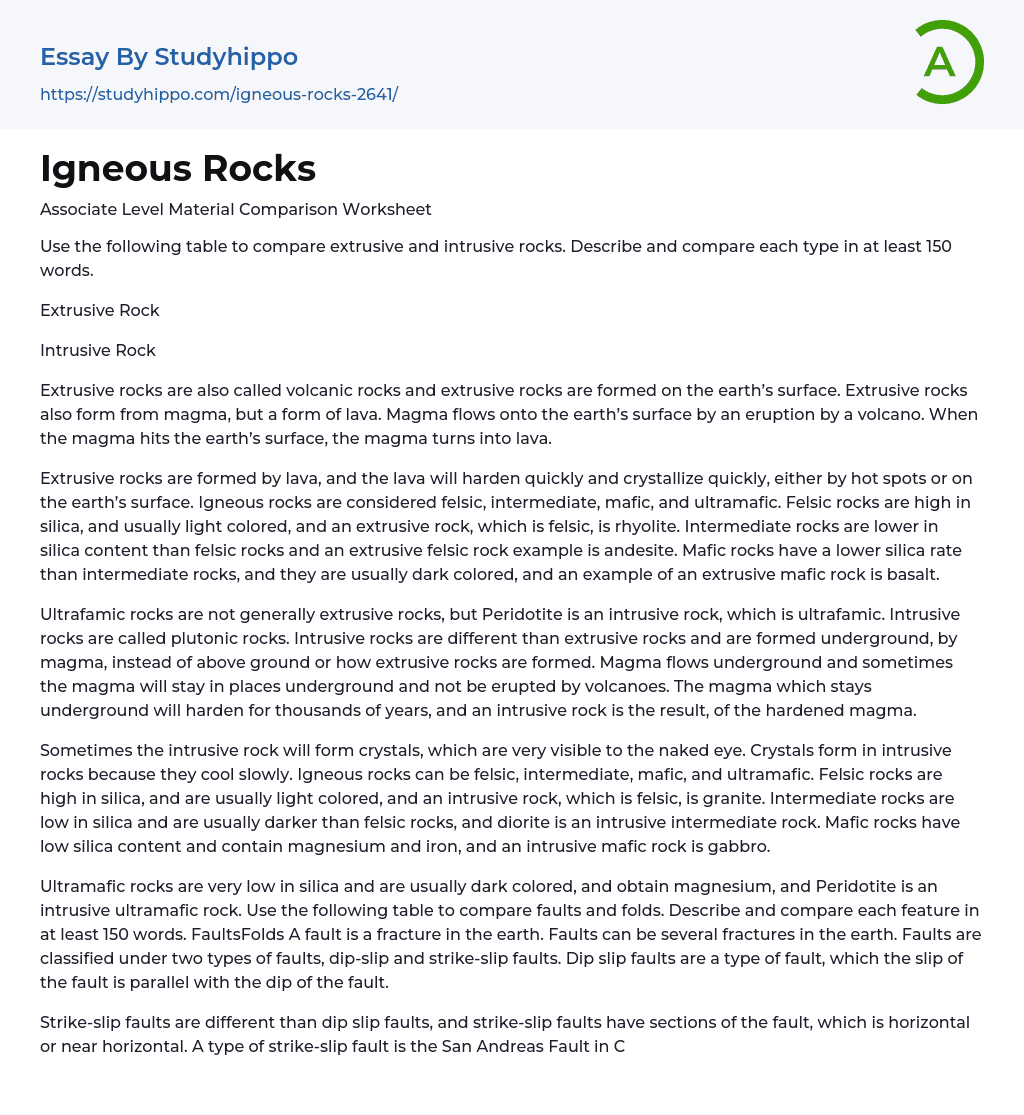Associate Level Material Comparison Worksheet
Use the table below to compare extrusive and intrusive rocks. Describe and compare each type in at least 150 words.
Extrusive Rock
Extrusive rocks, also known as volcanic rocks, are formed when magma reaches the earth's surface and cools into lava. These rocks are created through volcanic eruptions where lava flows onto the earth's surface.
Intrusive Rock
Intrusive rocks are formed beneath the earth's surface from magma. Similar to extrusive rocks, they originate from magma but instead of reaching the surface, it cools and solidifies underground to form intrusive rocks.
When the magma reaches the earth’s surface, it transforms into lava. Lava is responsible for the formation of extrusive rocks, which solidify and crystallize rapidly either through the presence of hot spots or directly on the earth’s surface. The classific
...ation of igneous rocks includes felsic, intermediate, mafic, and ultramafic. Felsic rocks are characterized by their high silica content and typically have light colors. An example of an extrusive felsic rock is rhyolite. Intermediate rocks have a lower silica content compared to felsic rocks, and an extrusive felsic rock example is andesite.
Mafic rocks have a lower silica rate compared to intermediate rocks and are typically dark in color. An example of an extrusive mafic rock is basalt. On the other hand, ultrafamic rocks are generally not extrusive but rather intrusive. One example of an intrusive ultrafamic rock is Peridotite. These intrusive rocks are known as plutonic rocks, unlike extrusive rocks which form on the Earth's surface. Intrusive rocks are formed underground through the solidification of magma, rather than being erupted above ground like extrusive rocks. Magma flows beneath the Earth's surface and may sometimes remain in plac
without volcanic eruption. Over thousands of years, the magma hardens to form intrusive rocks.
Intrusive rocks have visible crystals because they cool slowly. These rocks can be categorized as felsic, intermediate, mafic, or ultramafic. Felsic rocks, high in silica, are usually light-colored. Granite is an example of a felsic intrusive rock.
The text provides information about various types of rocks and their characteristics. It explains that felsic rocks are light in color and have a high silica content, while intermediate rocks are darker in color and have lower silica content compared to felsic rocks. An example of an intrusive intermediate rock is diorite. Conversely, mafic rocks have low silica content and contain magnesium and iron. Gabbro is given as an example of an intrusive mafic rock. Ultramafic rocks have very low silica content and typically appear dark due to their abundance of magnesium. Peridotite serves as an example of an intrusive ultramafic rock. The text then transitions to discussing faults and folds, defining a fault as a fracture occurring within the earth's crust.
Faults in the earth, also referred to as fractures, come in different types: dip-slip and strike-slip. Dip-slip faults are characterized by slip parallel to the fault's dip, while strike-slip faults consist mainly of horizontal sections. An example of a strike-slip fault is the San Andreas Fault found in California.
Some faults are categorized from different viewpoints, such as normal, reverse, thrust, and strike-up faults. A normal fault occurs when the rock above the fault surface moves downward in relation to the block below it. Conversely, a reverse fault involves the upward movement and displacement of the block above the fault surface over the lower block.
Thrust faults,
considered reverse faults, have a shallow dip angle. On the other hand, strike slip faults involve mostly parallel and horizontal movements along the fault's strike. Geologically speaking, a fold refers to a bend or deformation in stratified rocks resembling a wave. Certain folds are categorized as sedimentary rocks.
A fold is composed of three elements: two bends and one limb. The two outside ends are the limbs, while the middle section acts as the limb. Folds are tectonic structures or processes that bend in two opposite directions. They can be found in various orientations, such as upward, downward, curved, or inclined.
The text describes different types of folds and their classifications. An arch is an upward fold called an anticline, while a depression is a downward fold. A monocline is a steep fold that moves in one direction. Folds can be classified as vertical, inclined, or nonplunging and are commonly found in folded regions and cratons. Large folds occur along the edges of synclines and areas of the cratons. These folds can impact the distribution of facies, the thickness of sedimentary strata, and the accumulation of sediments in plate tectonics.
The presence of folds is sometimes connected to petroleum deposits. To identify extrusive and intrusive rocks, refer to the table below, which includes pictures. Select at least two intrusive rocks and two extrusive rocks and insert a picture of each rock in the Picture column. Provide a description of the physical characteristics for each rock and write a 50- to 100-word explanation concerning how these characteristics demonstrate whether it is an extrusive or intrusive rock.
- Hill essays
- Islands essays
- Agriculture essays
- Albert einstein essays
- Animals essays
- Archaeology essays
- Bear essays
- Biology essays
- Birds essays
- Butterfly essays
- Cat essays
- Charles Darwin essays
- Chemistry essays
- Dinosaur essays
- Discovery essays
- Dolphin essays
- Elephant essays
- Eli Whitney essays
- Environmental Science essays
- Evolution essays
- Fish essays
- Genetics essays
- Horse essays
- Human Evolution essays
- Isaac Newton essays
- Journal essays
- Linguistics essays
- Lion essays
- Logic essays
- Mars essays
- Methodology essays
- Mineralogy essays
- Monkey essays
- Moon essays
- Mythology essays
- Noam Chomsky essays
- Physics essays
- Plate Tectonics essays
- Progress essays
- Reaction Rate essays
- Roman Numerals essays
- Scientific essays
- Scientific Method essays
- Scientist essays
- Seismology essays
- Space Exploration essays
- Stars essays
- Sun essays
- Thomas Edison essays
- Tiger essays




